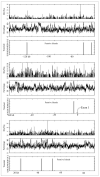Promoter, alternative splice forms, and genomic structure of protocadherin 15
- PMID: 17706913
- PMCID: PMC2043478
- DOI: 10.1016/j.ygeno.2007.06.007
Promoter, alternative splice forms, and genomic structure of protocadherin 15
Abstract
We originally showed that the protocadherin 15 gene (Pcdh15) is necessary for hearing and balance functions; mutations in Pcdh15 affect hair cell development in Ames waltzer (av) mice. Here we extend that study to understand better how Pcdh15 operates in a cell. The original report identified 33 exons in Pcdh15, with exon 1 being noncoding; additional exons of Pcdh15 have since been reported. The 33 exons of Pcdh15 described originally are embedded in 409 kb of mouse genomic sequence, while the corresponding exons of human PCDH15 are spread over 980 kb of genomic DNA; the exons in Pcdh15/PCDH15 range in size from 9 to approximately 2000 bp. The genomic organization of Pcdh15/PCDH15 bears similarity to that of cadherin 23, but differs significantly from other protocadherin genes, such as Pcdhalpha, beta, or gamma. A CpG island is located approximately 2900 bp upstream of the PCDH15 transcriptional start site. The Pcdh15/PCDH15 promoter lacks TATAA or CAAT sequences within 100 bases upstream of the transcription start site; deletion mapping showed that Pcdh15 harbors suppressor and enhancer elements. Preliminary searches for alternatively spliced transcripts of Pcdh15 identified novel splice variants not reported previously. Results from our study show that both mouse and human protocadherin 15 genes have complex genomic structures and transcription control mechanisms.
Figures







References
-
- Suzuki ST. Protocadherins and diversity of the cadherin superfamily. J Cell Sci. 1996;109(Pt 11):2609–11. - PubMed
-
- Suzuki ST. Recent progress in protocadherin research. Exp Cell Res. 2000;261:13–8. - PubMed
-
- Alagramam KN, Murcia CL, Kwon HY, Pawlowski KS, Wright CG, Woychik RP. The mouse Ames waltzer hearing-loss mutant is caused by mutation of Pcdh15, a novel protocadherin gene. Nat Genet. 2001;27:99–102. - PubMed
-
- Alagramam KN, Yuan H, Kuehn MH, Murcia CL, Wayne S, Srisailpathy CR, Lowry RB, Knaus R, Van Laer L, Bernier FP, Schwartz S, Lee C, Morton CC, Mullins RF, Ramesh A, Van Camp G, Hageman GS, Woychik RP, Smith RJ. Mutations in the novel protocadherin PCDH15 cause Usher syndrome type 1F. Hum Mol Genet. 2001;10:1709–18. - PubMed
Publication types
MeSH terms
Substances
Associated data
- Actions
- Actions
Grants and funding
LinkOut - more resources
Full Text Sources
Other Literature Sources
Molecular Biology Databases

